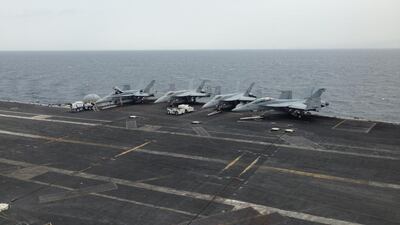ABOARD THE USS GEORGE HW BUSH // A US aircraft carrier was "harassed" and "threatened" by armed Revolutionary Guard vessels while passing through the Strait of Hormuz this week, as the ship's captain said the lack of stability and predictability from Iran was the main security threat facing the Arabian Gulf.The US navy said up to 20 small Iranian vessels were involved in the incident which took place on Tuesday as the USS George HW Bush was sailing to the northern Gulf to take part in anti-ISIL operations. It was not clear if all of the Iranian boats, known as Fast Inshore Attack Craft, were armed."The number one thing that bothers me is they [the Iranian vessels] had their weapons uncovered," said Rear Admiral Kenneth Whitesell, the commander of the USS George HW Bush carrier strike group – an operational formation of the US navy that includes around 70 aircraft and seven smaller vessels.
“The second thing that bothers me is that they had their weapons manned. And the third thing ... is they were loading their weapons while they were rendezvousing us and they were coming right after us.”
Admiral Whitesell described the incident – in which one of the carrier’s helicopters was threatened, according to the US navy – as “very aggressive”. At one point, an Iranian boat was less than 900 metres from the carrier.
“It’s unprofessional behaviour, it’s harassment behaviour and it’s something you wouldn’t expect when you’ve got a hundred giant vessels per day going through the Strait of Hormuz, and – at least from the flow of oil – the most critical strait in the world,” said Admiral Whitesell.
“This is their routine behaviour, which in any other area of the world, any other maritime environment, this would be seen as a violation of international law.”
Last year, there were 527 interactions between US naval forces and Iranian naval forces, 35 of which the US deemed to be unsafe or unprofessional on Iran’s part. Before Tuesday, there had been six such interactions so far this year.
The main security threat in the Gulf is the “instability and a lack of predictability we currently see from Iran”, the captain of the
USS George HW Bush
, Will Pennington, told
The National
following Tuesday’s encounter.
The lack of predictability from Iran “ebbs and flows, and certainly in recent times, if you would consider over the last three or four months, we have seen more”.
Admiral Whitesell said the US viewed threats to maritime security in the Bab Al Mandeb from Houthi militants in Yemen as “Iranian-sponsored activity”.
“So just a transference of capabilities to the Houthis in the Red Sea and Bab Al Mandeb. And that’s very disconcerting, very concerning to us.”
The
USS George HW Bush
launched air strikes on ISIL from the eastern Mediterranean before travelling to the Gulf.
Admiral Whitesell said the carrier would resume strikes against the extremists in Mosul and then in Aleppo and Raqqa from the Gulf either on Thursday or Friday after a three-week hiatus.
lmackenzie@thenational.ae

